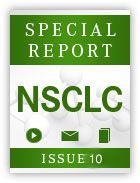NSCLC Study Shows Surprising Association Between Reduced Endocytic Activity and Metastases
Non-small cell lung cancer with mutations in the KRAS gene may be associated with reduced activity of a key endocytic pathway and a mesenchymal phenotype, which may cause metastases.
NSCLC Association Between Reduced Endocytic Activity and Metastases

Sandra Schmid, PhD
Non-small cell lung cancer (NSCLC) with mutations in theKRASgene may be associated with reduced activity of a key endocytic pathway and a mesenchymal phenotype, which may cause metastases, according to a poster presented on December 15 at the 2015 American Society for Cell Biology meeting in San Diego.
The finding reached statistical significance (P=.00003) when cell lines from 27 patients with NSCLC were measured against four variables, and the measurements were organized into two clusters by a computer program, according to Sandra Schmid, PhD, professor, chair of the cellular biology department, University of Texas Southwestern Medical Center in Dallas, and senior author on the paper that spurred the poster. The paper was recently published inCancer Research.
The four characteristics were the preponderance ofKRASmutations, whether the cell had an epithelial or mesenchymal phenotype based on a 76-gene signature, the ability of the cell line to migrate in three dimensions, and anchorage-independent growth, according to the paper.
When the researchers looked only at the link betweenKRASand endocytosis of cell surface marker cd44 via the clathrin-independent endocytic (CIE) pathway, the association fell short of statistical significance (P=.057), Schmid added.
A Possible New Basis for Categorizing Tumors
“Cells in the lung are normally epithelial, and as they become cancerous they go to a mesenchymal phenotype, which enhances their ability to migrate more efficiently and move, as you would expect cancer cells to do, in order to metastasize,” explained Sarah Elkin, BS, a doctoral candidate at the University of Texas, the lead author on the paper, and presenter of the poster.
“It’s known that mutations in theKRASgene are found in about 25% of cases of NSCLC. In our study, we found that cluster one, in which cells tended to have a more mesenchymal phenotype, had low endocytotic activity and was found to be enriched with mutations inKRAS. Cluster two had higher endocytotic activity and had lessKRASmutations,” Elkin added, noting that the cells in the second cluster tended to have an epithelial phenotype.
“Previously, lung cancers were classified according to whether they were adenocarcinoma, small cells, or non-small cells, and now we’re getting into what is each person’s genetic profile,” Elkin said. “We think endocytosis could be another way of determining the best treatment option,” she added.
Surprising Variation Among Cell Lines
“There were many reviews suggesting that all three endocytic pathways would be dysregulated, but our surprising finding was that across many cell lines there was quite a variability,” Schmid said. “On average, endocytotic activity in the tumor cells was about 50% lower when compared with healthy cells that were genetically identical, but some were also higher, and some were unchanged.” The level in endocytotic activity varied from a drop of 4-fold to an increase of more than 2-fold, she noted.
“The activity we found most correlated with the epithelial cancer cell phenotype, endocytosis via the CIE pathway, was, on average, only one-tenth as high in cells with aggressive characteristics,” said Schmid.
However, there was a greater-than-expected amount of heterogeneity among the cell lines. For example, there was a 40-fold range in the amount of clathrin-independent endocytosis exhibited, Schmid said.
The researchers looked at three endocytotic pathways: the CIE pathway, clathrin-mediated endocytosis, and the caveolae-mediated pathway, the article enumerated.
"Clathrin-mediated endocytosis was first discovered several decades ago, when people were able to look in a microscope and see that clathrin forms this shell, which creates a curvature that allows vesicles to be pinched off and internalized,” explained Elkin.
“Caveolae is another protein that can be recruited to the plasma membrane,” she continued. Scientists assume its function is similar to that of clathrin, because nobody knows how else the molecules or ligands that have been internalized from the plasma membrane can get into the cell. “But to date nobody has been able to find any structures like the lattices found in the clathrin-mediated pathway,” she added.
The researchers were also surprised to see no correlation between clathrin-mediated or caveolae-mediated endocytosis, the article said.
Changes in cells’ endocytotic machinery have also been implicated in prostate and breast cancer, Elkin noted.
Innovative Technique
The researchers chose to study the role of endocytosis in NSCLC because they had access to a well-characterized bank of cells. “One of our collaborators at UT Southwestern, John D. Minna, MD, has been collecting NSCLC cells from patients for decades, and these offer a wide-enough variety to give us a good pool. He has also done extensive characterization, so we knew whether the cells came from a primary tumor or metastasis, and we also knew the genetic makeup,” said Elkin.
The researchers examined cell lines from 27 patients and measured a variety of characteristics. “We didn’t perturb the cells, but just took a snapshot, and measured, for example, whether endocytosis was abnormally low or high in one cluster or another,” she added.
In addition to endocytosis and mesenchymal phenotype, the researchers also measured the ability of the cell lines to migrate and grow.
“Normal cells can only grow in two dimensions on plastic, and they need to be surrounded by other cells, so when you put normal cells in soft agar, they can’t grow because they don’t have anything to anchor themselves down into. But cancer cells, having lost control of their signaling pathways, can grow into colonies very effectively,” Elkin explained. The researchers found that cells in cluster one (high inKRASmutations and low in endocytosis) could migrate efficiently, while those in cluster two (low inKRASmutations and high in endocytosis) could grow more efficiently, she added.
The researchers also compared the cells with healthy tissue from two of the same patients as well as retinal cells and human bronchial epithelial cells from other humans who did not furnish cancer cells.
To carry out the measurements, the researchers used a novel, open-source technique referred to as an ‘in-cell ELISA.’
"Because we work with cells on 96-well plates, it was 10 times faster. What would take a week, we were doing in an afternoon,” noted Schmid.
The assay was developed by one of the coauthors, Carlos Reyes, PhD, a postdoctoral fellow in the laboratory, she added.
The results were found to have statistical significance, notwithstanding the small number of humans involved, because the differences were large, and the experiment included thousands of individual measurements, Schmid said.
The researchers are trying to better understand exactly which pieces of the endocytotic machinery are altered. “We started with five cell lines, and are now down to one or two,” said Elkin, who added that a postdoctoral colleague in the laboratory hopes to publish something on the new research in 2016.
References
- Elkin S. Non-Small Cell Lung Cancers Can Be Sorted in Clusters by Endocytic Changes. Poster presented at: American Society for Cell Biology Annual Meeting; December 15, 2015; San Diego, California.
- Elkin S, Bendris N, Reis C, et al. A systematic analysis reveals heterogeneous changes in the endocytic activities of cancer cells.Cancer Res. 2015;75(21):4640-4650. doi:10.1158/0008-5472.CAN-15-0939.
